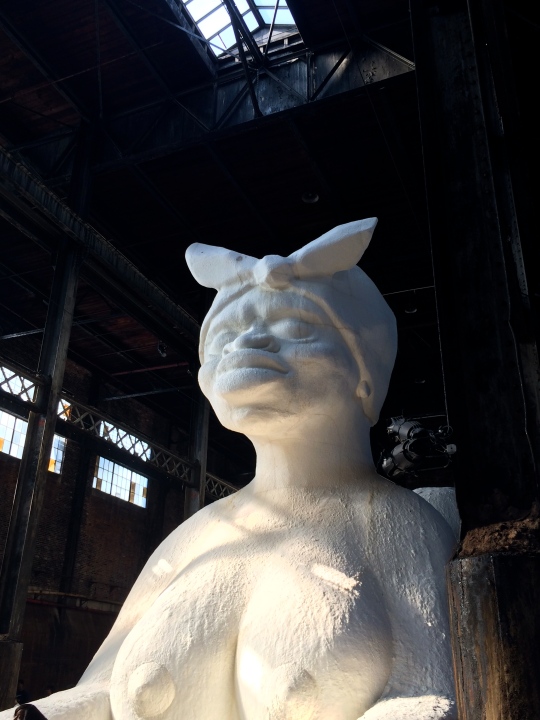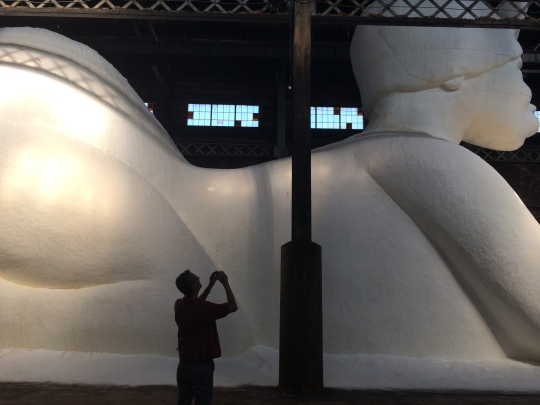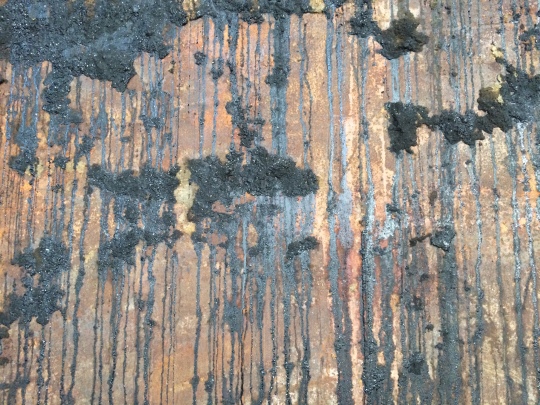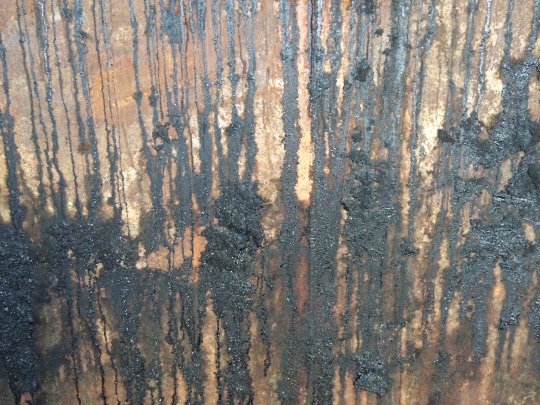
Kara Walker
In New York, we love lines. If there is a line, that is where we want to be. So, in the last few years, we have stood in line for events like Christian Marclay’s The Clock, Yayoi Kusama’s infinity room at David Zwirner, Doug Wheeler’s light room also at David Zwirner, the rain room at MOMA. And now, the place to be is the Kara Walker exhibit at the soon to be torn down Domino Sugar Factory in Williamsburg, Brooklyn.
Kara Walker is a contemporary mid-career artist who is known for scenes done in black paper-cut silhouettes. At first glance, the paper cuts look like something you might stencil in the baby’s room, but they depict scenes involving rape, violence, sex and slavery. Although the images in her work are mostly from the pre-Civil War south, they are also a commentary on abuses that exist around the world today.

Kara Walker “Auntie Walker’s Wall Sampler for Civilians” (detail), 2013. Courtesy of Sikkema Jenkins & Co., New York © Kara Walker.
The scale of her pieces can go from one extreme to another — from floor-to-ceiling wall murals (above) to small cut outs in vitrines or on table tops (below).

Burning African Village Play Set with Big House and Lynching at the Brooklyn Museum
Walker’s work, which deals with issues of race, gender, violence and sexuality can be unsettling and repulsive and ambiguous and contradictory. It can be very controversial. A recent New York times feature mentions how veteran black artist Betye Saar criticized Walker for “her negative stereotypes of blacks as both victims and aggressors.” Walker has been awarded a MacArthur genius grant, her works are included in many museum collections.
Her current installation is different from her well-known silhouettes. On Friday afternoon, June 27th, the line to get into Walker’s current show stretched for about six blocks down Kent Avenue in Williamsburg.
Once in the show, you walk into the cavernous, now abandoned, sugar refinery to see a giant sphinx-like sugar mammy at the opposite end. Entitled “A Subtlety,” there is nothing subtle about it. (By the way, a subtlety is a medieval sculpture made of sugar or marzipan for royal families, often to decorate tables)
As you walk towards her, there are smaller molasses children. Many of them are carrying baskets. To me they seemed to be reminders of child labor (which I had just seen featured the night before on The Daily Show in a feature about children working in tobacco fields). Walker based them on some 10-inch slave boy knickknacks she had purchased on amazon.
At this point in the exhibit–which has been open since April–a number of the sugar children have melted under the heat of the factory and have toppled to the ground and broken.

Kara Walker’s installation deals with many of the issues she has addressed in the past. The sphinx is a stereotype of the handkerchief wearing mammy who took care of white families’ children. In addition, she represents a stereotype of an overly sexualized black woman.
In 1984, Sheena Easton had a controversial hit with the song “Sugar Walls” written by Prince.
Some of the lyrics:
“Come spend the night inside my sugar walls
I can tell you want me
It’s impossible to hide
Your body’s on fire
Admit it come inside
My sugar walls
My sugar walls
Come inside
My sugar walls
My sugar walls”
TV and radio stations refused to air the song because sugar walls referred to the walls of a “vagina.” Well, Kara Walker’s sculpture includes the ultimate “sugar walls:”
The Domino Sugar Refinery was built in 1856 and for some time was producing half of the sugar in the United States. The refinery, which is about to be torn down to make room for luxury residences, still has the smell of molasses and sugar can be seen every where–dripping down the walls, at the top of pillars, in every crevasse and behind every wall. Sugar, which was at one time a luxury product, is making room, for a modern day luxury product.
The walls of the refinery look like abstract paintings:
The show ends July 6, 2014
More Information
NY Times on the exhibit
An excellent ten-minute in-depth look at the creation of the project (video with Walker in it)
Interview with Walker in The Brooklyn Rail on how the exhibit developed
Jerry Saltz’s reaction to the exhibit
Poetry, prose and illustrations related to the exhibition’s central themes, from five innovative and internationally renowned writers and artist on the Exhibit’s website
A discussion and guide to Walker’s art work
Video from the Live at NY Public Library Event (excerpt of interview starts 2 minutes in)












Karen Ruelle
Great write-up, Wendi. I like the Prince reference! We saw the exhibit closer to its opening and all the sugar children were still pretty much intact. Fascinating and disturbing to see how they’ve degraded.
wendieatsandreads
Thanks, Karen. Yes, the sugar children were disintegrating in different ways–sometimes they fell over in one piece and others had broken in hundreds of pieces. On one of them, you can see a metal bar that forms the structure of the statue.